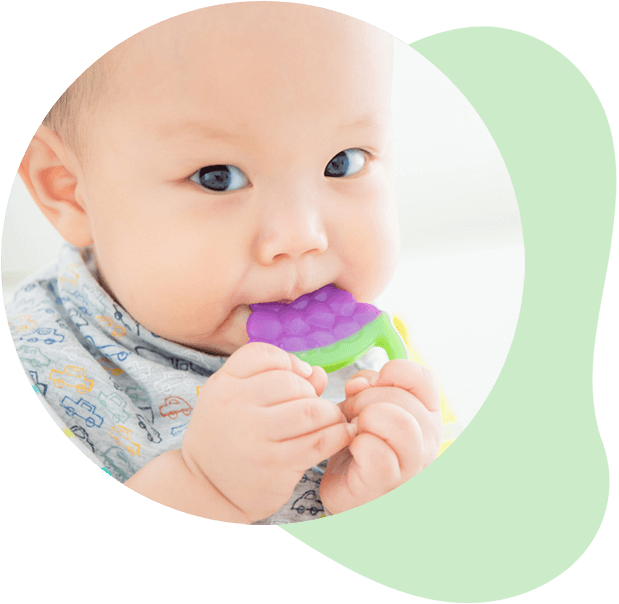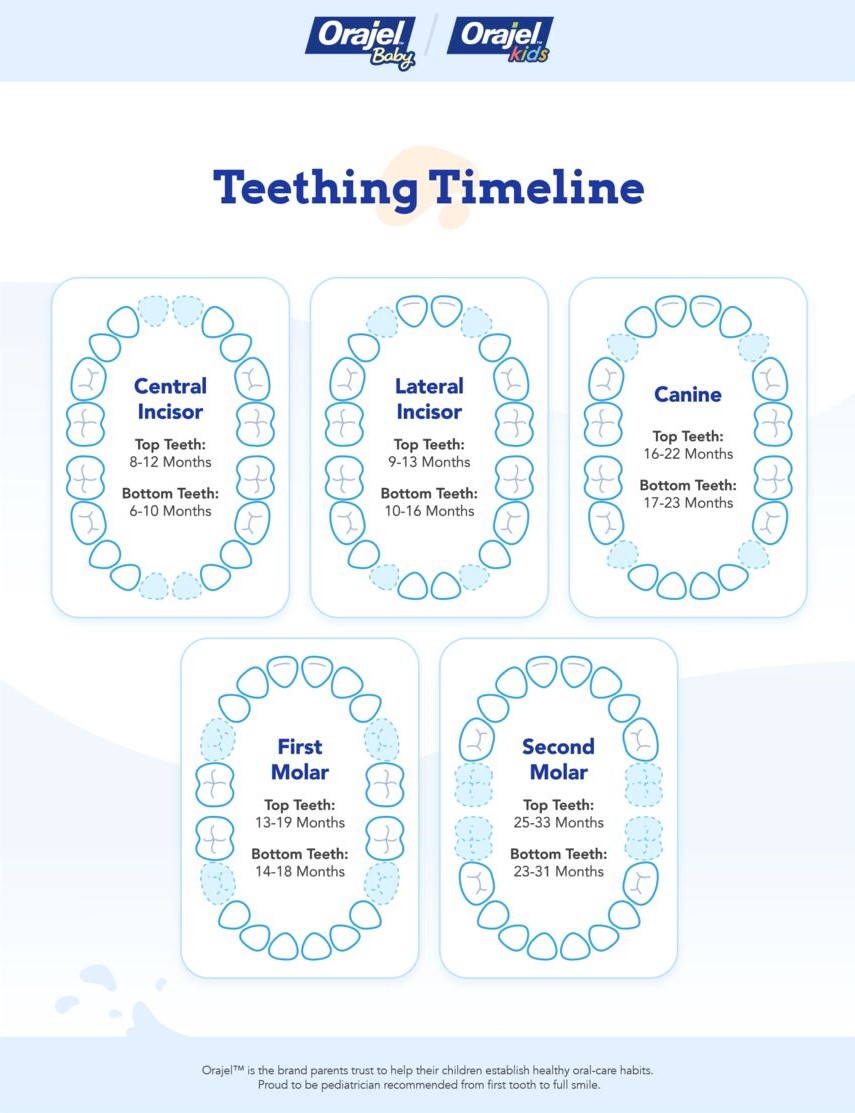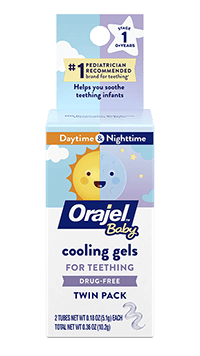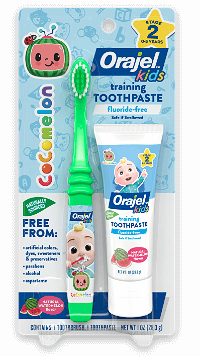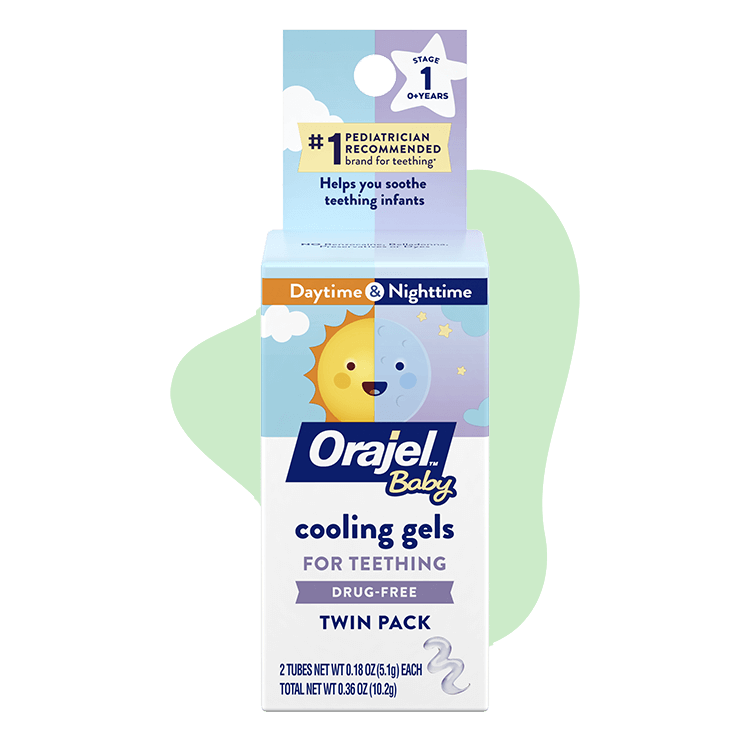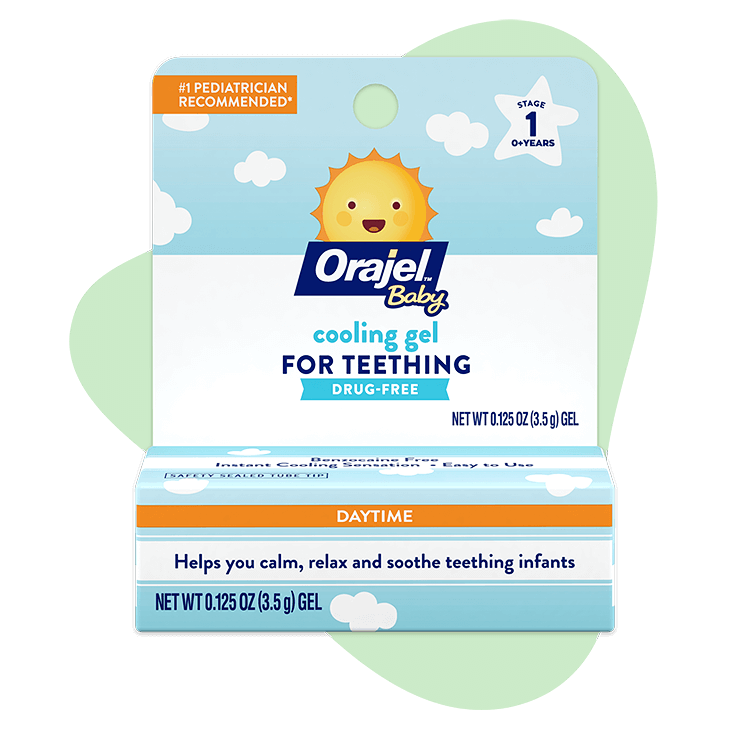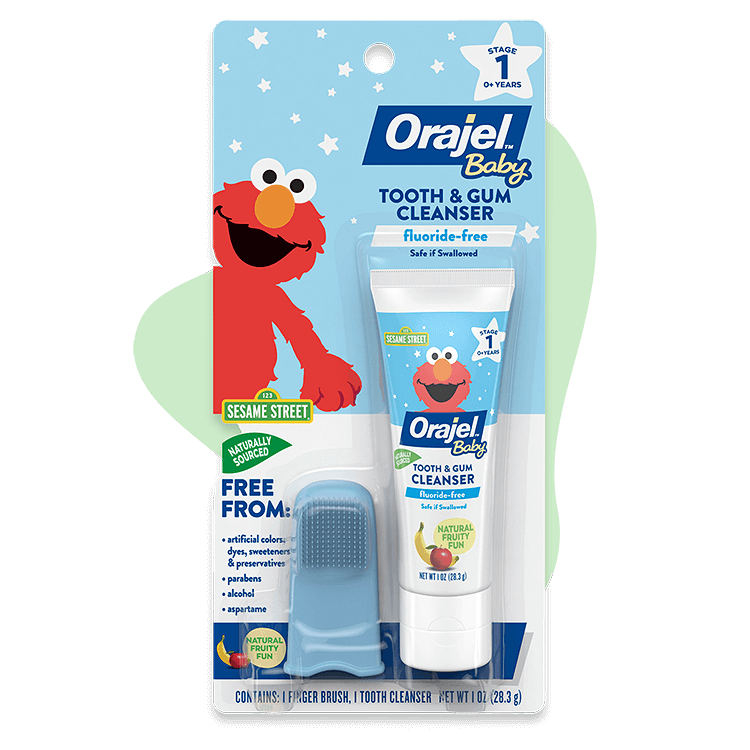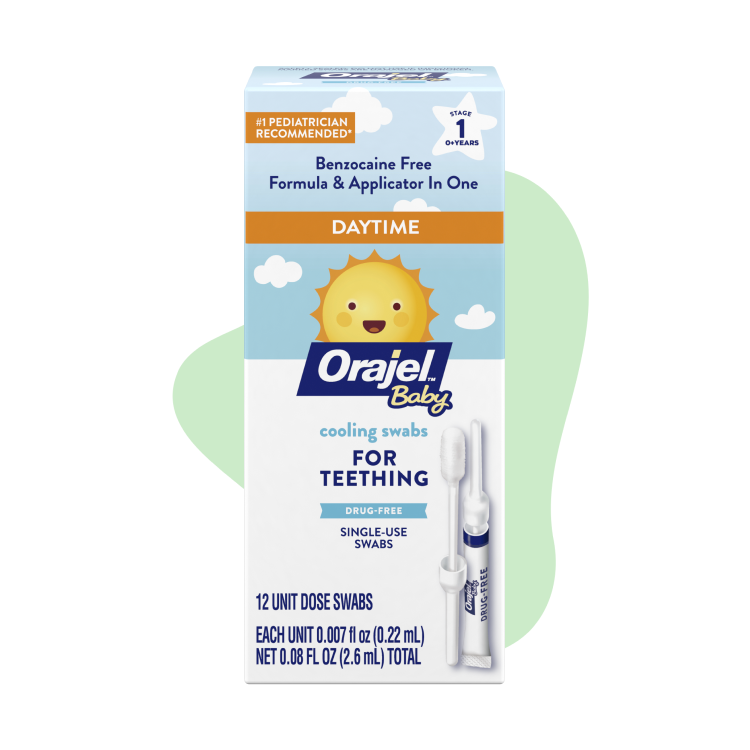Seeing those little chompers start to break through the gums can provide a heartwarming moment! But do you know how old your child will be when that first tooth begins to appear, and exactly which tooth erupts first? When do babies start teething, anyway?
Although every baby is different, you can refer to our teething chart below for some guidance on when your kiddo’s milk teeth (aka baby teeth, primary teeth, or deciduous teeth) will likely start coming through the gums, and the order in which they appear. Additionally, we’ll discuss some signs of teething so you can better understand where your child might be in the process and address any potential discomfort that may arise from teething.
When Do Baby Teeth Come In?
Baby teeth typically break through the gums at around 6 months of age, on average. However, some infants start teething as early as 3 months while other babies’ teething age may come closer to 12 months or later.
Milk teeth begin forming when the child is still in the womb and babies are born with a full set of 20 primary teeth hidden in their jawbones. You’re only waiting for them to break through the gums. Baby girls generally start teething before baby boys. So, while you may not have an exact sense of your infant’s teething schedule, these tidbits may help inform your expectations if you plan to chart tooth eruption.
How Do You Know if Your Infant is Teething?
Your child might have started cutting teeth, even if you’ve yet to spot those baby chompers! A mild fever (less than 102° F), decreased appetite, and increased drooling or fussiness are potential signs and symptoms of infant teething.
What Are Baby’s First Teeth to Come In?
When your baby starts teething, the first teeth to come in are the central incisors, or two up-front teeth in the middle of the mouth. Infants typically start getting their bottom central incisors between 6 to 10 months, with the top teeth coming around 8 to 12 months.
The central incisors and all the subsequent baby teeth that ultimately erupt through the gums typically come in pairs. That means if the bottom right and bottom left central incisor will break through at the same or similar times.
Seeing those front milk teeth come in might elicit any number of emotions as a parent. Your kiddo is growing up in a hurry! It may also help give that adorable little smile some added definition, talk about cuteness overload! What about the rest of those deciduous teeth? When do they start to arrive? And how many primary teeth do infants and children get?
Baby Tooth Eruption Chart: Order of Appearance
Eager to peek at those primary teeth and find out when your baby’s first set of teeth will arrive? Use this teething age chart as a guideline to understand when you might start seeing a small white bud breaking through your infant’s gums!
|
Tooth Type |
Top Teeth |
Bottom Teeth |
|
Central Incisors |
8-12 months |
6-10 months |
|
Lateral Incisors |
9-13 months |
10-16 months |
|
First Molars |
13-19 months |
14-18 months |
|
Canines |
16-22 months |
17-23 months |
|
Second Molars |
25-33 months |
23-31 months |
The teeth should come in symmetrically, meaning the left and right of each milk tooth pop up at similar or the same times. Let’s take a closer look at the function of the various deciduous teeth:
1. Central Incisors
As we’ve discussed, the central incisors are your infant’s first teeth. They help your infant bite food into small, chewable pieces. That comes in handy when your child is graduating from just milk to soft foods!
2. Lateral Incisors
The lateral incisors, which are located between the front teeth and canines, are the second primary teeth to start erupting through the gums during teething. Like the central incisors, lateral incisors help cut food during chewing.
3. First Molars
Your baby gets two sets of molars, which are the rectangular teeth in the back of the mouth that have a flat surface to help grind food down. They are the largest teeth in the mouth and help crush food.
4. Canines
Canines are located next to the lateral incisors and have an especially pointy shape, with a sharper edge that can help to grip and tear food apart. They also help guide the mouth closed when the top and bottom jaw converge.
5. Second Molars
Unlike the first molars, the bottom second molars start coming through before the top teeth. These molars offer additional support in crushing food for consumption.
How Long Does it Take for a Tooth to Break Through the Gums?
Once a fully developed tooth is ready under the gums, it will usually take a couple days for tooth eruption to occur. However, your infant may experience teething symptoms for about a week until the tooth breaks through.
When Should You Start Brushing Babies’ Teeth?
According to the American Academy of Pediatric Dentistry, you should start brushing babies’ teeth as soon as the very first tooth erupts through the gums. Parents should use a smear of fluoride toothpaste and soft-bristled toothbrush, and brush teeth and gums twice daily.
Orajel™ Kids has anticavity toothpastes that help protect against cavities, strengthen teeth and keep gums healthy. They come pediatrician recommended and come with fun character connections!
Is it Normal for a Baby to Not Have Teeth at 12 Months?
Although infants usually begin cutting teeth between 6 and 12 months, delayed teething—or not developing any teeth after 12 months or later—may happen for your 1-year-old. Late teething may happen up to 15 months of age. It may not be “normal,” but delayed teething does happen!
That said, you should carefully examine your child’s progress if they still have not started teething by 15 months old. The American Academy of Pediatrics recommends consulting a pediatric dentist if your baby has not begun to develop teeth after 18 months.
How Many Teeth Do 3-Year-Olds Have?
In all, your child should have 20 primary teeth by the time they are 3 years old, with the top second molars sometimes waiting to emerge until 33 months. That’s 8 incisors, 4 canines, and 8 molars.
In other words, ignore the myths about toddler teething not being a thing. Your baby will be in the process of teething from around 6 months to around age 3. Then you’ll have a couple years of respite before these first teeth start getting loose and falling out and the permanent teeth come in to replace them.
What are Primary Teeth Used For?
Primary teeth don’t just help with chewing. They also help your little one smile, speak and form words correctly as they age! Plus, milk teeth save space for adult teeth to grow in place. Your child’s first permanent teeth may come in at around age 5, with the adult tooth version of the second molars typically arriving between the ages of 10 and 12.
Use Orajel™ Baby Teething Gels to Help Soothe Gums
It’s quite exciting to think about your infant getting teeth. Still, teething can lead to some discomfort for your child. If you spy deciduous teeth erupting through the gums or your little one starts showing signs of teething, try Orajel™ Baby Teething Gels! These gels (or swabs) help to calm, relax and soothe teething infants. They are also benzocaine-free and also come without any sugars, artificial colors or parabens.
Getting a break from discomfort and crying is important, both for your baby and for you as a parent working around the clock to nurture your child or children. Reach for Orajel™ Baby Teething Gels to help calm and soothe your child and give yourself a breather from the crying and irritation:
- If the sun is still high in the sky, try Orajel™ Baby Daytime Gel or Orajel™ Baby Daytime Cooling Swabs for Teething. You can also try Orajel™ Baby Daytime Cooling Tablets, which are fortified with Vitamin D for healthy tooth support.
- Once the moon comes up and you’re getting your infant ready for bed, you can reach for Orajel™ Baby Nighttime Cooling Gel.
- Orajel™ Baby Daytime + Nighttime Cooling Gels for Teething is a twin pack that includes both of those offerings!
You can always consult the above teething chart in anticipation of when tooth eruption may occur. But regardless of when that timeline begins, Orajel™ Baby Teething Gels and Swabs are here to provide comfort for you and your kiddo!


